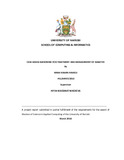Case Based Reasoning For Treatment And Management Of Diabetes
Abstract
This study focused on the use of case based reasoning (CBR) for treatment and management of diabetes. CBR is a field of artificial intelligence where one uses past cases as resolution for similar problems. The concept is based on dynamic memory theory where human beings solve problems by recalling encountered cases.
This project applies CBR in the field of medicine for treatment and management of diabetes. Diabetes is a family of metabolic disease condition where the patient has elevated blood glucose. There is a rise on the prevalence of diabetes in Kenya with over 2 Million Kenyans suffering from the condition. Damage to nerves, heart failure, kidney failure, blindness and amputations are among the diabetes associated complications. Some of the key challenges encountered during the management of diabetes include lack of insulin, high cost of drugs, an overworked workforce and low awareness among others.
A prototype was developed using JCOLIBRI framework and trained with a total of 60 cases. 40 cases were type 1 and the remaining 20 cases type 2. A test data of 20 cases was used to measure the accuracy of the system. The key variables used in test were blood glucose, HBA1C (average blood glucose over 3 months), weight and height. The diagnosis predicted by the system were compared against the one obtained by the expert and the results were as follows: When tested with the 3 parameters (Blood Glucose, Height & Weight) the system had a mean accuracy of 28% before revision (3rd Cycle of CBR) and after the first revision (3rd Cycle of CBR) the system attained a mean accuracy of 70% with the 3 parameters. When tested with 1 parameter (Blood Sugar) after revision (3rd Cycle of CBR) the system returned a mean accuracy of 90%.The accuracy was based on the difference of solution applied between an expert judgment and the system judgment. The level of blood glucose is the key factor to consider during diabetes diagnosis.CBR is more accurate after revision cycle and as the number of cases increased
Publisher
University of Nairobi
Rights
Attribution-NonCommercial-NoDerivs 3.0 United StatesUsage Rights
http://creativecommons.org/licenses/by-nc-nd/3.0/us/Collections
The following license files are associated with this item:


